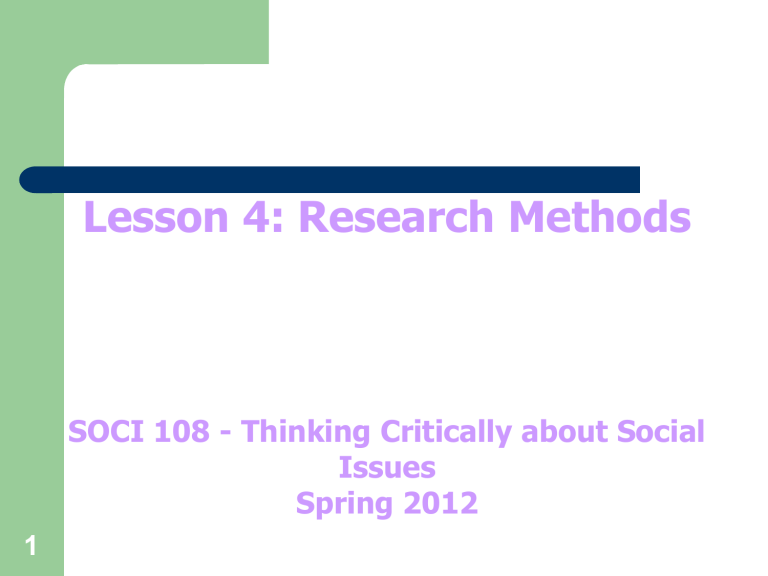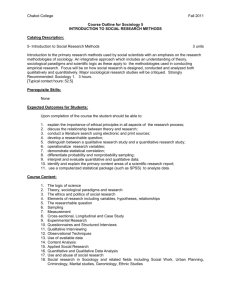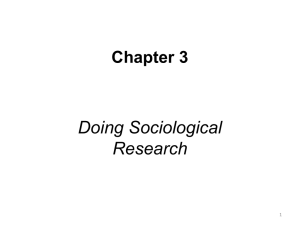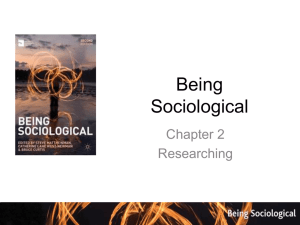Research Methods

Lesson 4: Research Methods
1
SOCI 108 - Thinking Critically about Social
Issues
Spring 2012
2
Damned Lies and Statistics
Statistical Benchmarks:
U.S. population +/- 310 million
About 4 million babies born every year
About 2.4 million die every year
1 in 4 from heart disease (1,206,374 deaths in
2004), cancer too
Traffic accidents: 43,000 people (about 1 or 2%), breast cancer: 40,000, homicide: 17k, suicide 32k
3
In general, the worse things are, the less common they are
As a general rule, advocates prefer to define social problems as broadly as possible:
First, advocates claim they are drawing attention to the issue
Second, they allow advocates to count more cases
4
An Overview of Research Methods
Quantitative research uses data that can easily be converted into numbers, such as a survey or an experiment.
Qualitative research involves data that cannot easily be converted to numbers, such as observation or informal interviews.
5
An Overview of Research Methods
(cont ’ d)
Most sociological research uses the scientific method , which is the standard for acquiring and verifying empirical (scientific) knowledge.
Why is the use of the scientific method so important?
– What is the alternative?
6
An Overview of Research Methods
(cont ’ d)
After conducting a literature review , are searcher forms a hypothesis (study time affects exam grade) stating a potential relationship between two or more variables
(study time, exam grade).
7
An Overview of Research Methods
(cont ’ d)
These variables must be clearly defined so that they can be measured.
Variables must be operationalized , that is defined in such a way that can be measured.
Finally, data is collected and the hypothesis can be tested.
8
Qualitative Methods
One way to collect to data is through ethnography , a naturalistic method based on studying people in their own environment in order to understand the meanings they attribute to their activities.
Ethnography is often a two-part activity: active participation in and observation of a naturally occurring setting, and a written account (field notes) of what goes on there.
9
Qualitative Methods
In participant observation the researcher both observes and becomes a member in a social setting.
10
Qualitative Methods
Interviews involve direct, face-to-face contact with respondents, and often can generate large amounts of qualitative data.
As in most research, the researcher identifies the target population that she wishes to study, and then selects a sample of people to be interviewed from that population.
Why use a sample?
11
Qualitative Methods (cont)
Interviews:
– A closed-ended question imposes a limit on the possible responses: for example, “ Are you for or against couples living together before they are married?
”
– An open-ended question allows the answer to take whatever from the respondent chooses: “ What do you think about couples living together before they are married?
”
Why use one over the other?
12
Quantitative Methods
Surveys are questionnaires that are administered to a sample of respondents selected from a target population.
Survey research tends to look at large-scale social patterns and employs statistics and other mathematical means of analysis.
Most commonly used research method in sociology!
– How come?
13
Quantitative Methods (cont)
Experiments are formal tests of specific variables and effects that are performed in a controlled setting where all aspects of the situation can be controlled.
Used to demonstrate cause and effect
Least commonly used method in sociology
– How come?
14
Quantitative Methods (cont)
Many experiments involve using an experimental group , which is the part of the test group that receives the experimental treatment, and a control group , which is the part of the test group that is allowed to continue without intervention so that it can be compared with the experimental group.
15
Quantitative Methods (cont)
A researcher will investigate whether an independent variable (IV) causes changes in the dependent variable (DV).
IV comes first (time order)
DV is effected by the IV; comes after the IV in time
16
Existing Sources
Existing Sources refer to any data that has already been collected by earlier researchers and is available for future research.
This can include sources such as census data, newspapers, photography, and cultural artifacts.
Using existing data is usually less involved than collecting original data and also gives researchers access to distant places and times.
17
Issues in Sociological Research
The research methods described so far are often applied outside the field of sociology.
Some examples include the US Census, political campaign offices, business, and market research.
18
Issues in Sociological Research
(cont ’ d)
Most sociologists believe that they should not allow their personal beliefs to influence their research.
Max Weber wrote the classic sociological statement on this issue.
He coined the phrase value-free sociology , an ideal whereby researchers identify facts without allowing their own personal beliefs or biases to interfere.
How likely is this?
19
Issues in Sociological Research
(cont ’ d)
The American Sociological Association has developed its own set of code of ethics to assist researchers avoid bias, adhere to professional standards, and protect respondents from harm.
ASA Code of Ethics
Why is a code of ethics necessary?
20
Issues in Sociological Research
(cont ’ d)
The case of Laud Humphreys and the Tearoom
Trade
–
‘ Watchqueen ’
–
–
–
–
–
License plates
54% of the men were married
38% were neither bisexual nor homosexual
Most of the men were successful, well educated, economically stable, and highly praised in the community.
Only 14% of the men he observed were homosexual and part of the gay community
21
Issues in Sociological Research
(cont ’ d)
Most universities where research is conducted also have an institutional review board , a group of scholars within a university who meet regularly to review and approve the research proposals of their colleagues and make recommendations for how to protect human subjects.







